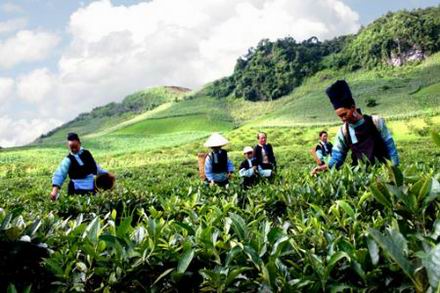
In recent years, Son La has
become known for not only having the biggest hydroelectric power plant in
Southeast Asia but also for its geographical conditions, natural beauties,
and fresh air. It is also a famous destination of Vietnam tour.About 300km
from the capital,
Hanoi, Son La is located on Highway No.6, which links with
Highway No.279 and No.32 forming a touristic arc through the northwestern
region connecting
Dien Bien,
Lai Chau, Lao Cai, and
Yen Bai provinces.
Son La province possesses mountainous terrain, divided by the Da and Ma
rivers to form the
Moc Chau and Na San Plateaus. The limestone geology and
karst topography eroded over millions of years, have created wonderful caves
such as Chi Day in Yen Chau district, and Ban On and Doi in Moc Chau
district. The diversity in biology and terrain, which is divided into three
areas, forms various sub-climates, with an average temperature of 21 degrees
Celsius. Typically, Moc Chau Plateau is known as a cool land with favorable
conditions for dairy farming, tea and temperate fruit trees, and is now
emerging as a major tourist area in the
northwest.
Visitors have many chances to enjoy a variety of ethnic minority festivals,
each with their unique culture. According to leading folklore and cultural
researcher, Professor Dr. To Ngoc Thanh, Son La is the cradle of the ethnic
minority culture in the Northwest. In recent years, the artistic and
cultural movement has seen rapid growth and the province now has more than
900 art troupes that regularly perform to promote the image of Son La.
The number of travelers to Son La tour has increased remarkably to about
380,000 visitors in 2010, 2.4 times more than in 2005. The number of
international tourists reached 32,000, nearly double that of 2005. Earnings
from tourism reached VND 185 billion, contributing significantly to local
socio-economic development. Hotels and guest houses have been blooming in
number, and the province has now 105 facilities with 1,500 rooms including
28 hotels and 75 motels that met the initial demands of visitors.
Despite its great potential for tourism and relatively high tourism growth,
the province has yet to live up to its potential. The local authorities are
aware of the fact, but since there are many difficulties in the province,
attention is not duly paid to developing tourism.
Over the past 20 years, the province has registered, catalogued and designed
plans for promoting many relic sites but little investment has been made
apart from the Son La Prison and Moc Chau Plateau.
Against such conditions, the province needs to protect the sites and prevent
encroachment that could result in difficult and expensive land clearances in
the future. Calling for investment is important but the province should
proceed with caution to find investors with real financial strength and
enthusiasm.
“It is necessary to have a vision, as well as a sound plan and strategy to
manage and develop tourism in the province,” said the Deputy Director of Son
La Department of Culture, Sports and Tourism, Luong Van Dinh. Being aware of
and overcoming weaknesses are critical for developing tourism to its fullest
potential, he added.
The provincial authorities have decided to organise the ‘Crossing Northwest
– Son La 2011' tourism programme from August 27 to September 2 this year. It
will be the biggest tourism promotional event so far in the four northern
mountainous provinces of
Hoa Binh, Son La, Dien Bien and Lai Chau.
With its natural and cultural potential, tourism would be important for
rapidly and sustainably reducing poverty. When the Son La hydro-electric
power plant comes into operation, it will also be a highlight for the
stronger development of ‘clean industry’ in the province.
Read More:


